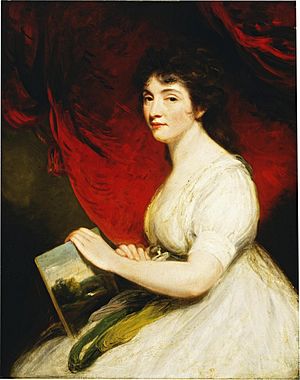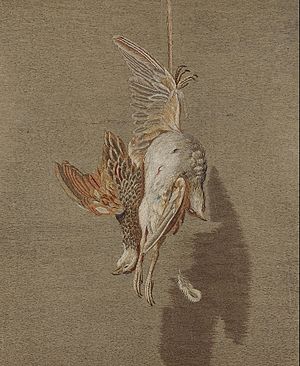Mary Linwood facts for kids
Quick facts for kids
Mary Linwood
|
|
|---|---|

Mary Linwood, oil on canvas, c. 1800, John Hoppner
|
|
| Born | 1755 Birmingham, England
|
| Died | 1845 London, England
|
| Other names | Heena Scott |
| Occupation | Needle woman, school mistress |
Mary Linwood (1755–1845) was a famous English artist. She was known for her amazing needlework, especially her detailed worsted embroidery. Mary showed her beautiful art in cities like Leicester and London. She also ran a private school for girls, which later became known as Mary Linwood Comprehensive School. In 1790, she was honored with a special medal from the Society of Arts for her talent.
Contents
About Mary Linwood
Early Life and Family
Mary Linwood was born in Birmingham, England, in 1755. When she was nine years old, her family moved to Leicester because her father, who was a wine merchant, faced financial difficulties. Sadly, her father passed away when Mary was young. Her mother then opened a private boarding school for young ladies to support the family.
After her mother died, Mary took over the school. She continued to run it successfully for 50 years! Mary created her very first embroidered picture when she was just thirteen. By 1775, she was already recognized as a skilled needlework artist. When she was 31, even the royal family noticed her work. Queen Charlotte invited Mary to Windsor Castle to show her art, along with other talented needle artists like Mary Delaney and Mary Knowles.
Amazing Art Exhibitions
Mary Linwood spent nearly 75 years creating art with worsted embroidery. She made over 100 pictures, many of them large copies of famous paintings by old masters. These copies were made using crewel wool, which is a special type of wool. Her unique stitches looked like real brushstrokes, making her work incredibly lifelike.
Her first big exhibition opened in London in 1798 at the Hanover Square Rooms. This show later traveled to other major cities like Edinburgh and Dublin. Mary's work became very famous. She even met many kings and queens from across Europe! She exhibited her art in Russia, and Catherine the Great offered her a huge amount of money, £40,000, for her entire collection. The Tsar even offered £3,000 for just one of her pieces! However, Mary refused these offers because she wanted her art to stay in England.
Once, her copy of a painting by the Italian artist Salvator Rosa sold for more money than the original painting! One of her own designs, called Judgement of Cain, took her ten years to finish.
Her exhibition in Leicester Square, London, was very modern for its time. It was one of the first art shows to use gaslight for illumination. It also had creative displays with red, silver, and gold curtains, making it feel like you were peeking into a cozy cottage window. The exhibition featured copies of paintings by famous artists such as Carlo Dolci, Guido, Ruisdael, and Gainsborough. Mary also created portraits of important figures like Lady Jane Grey and Napoleon. It's said that her portrait of Napoleon was done while he was posing for her! Napoleon was so impressed that he gave her the Freedom of Paris in 1803.
Mary's annual shows were incredibly popular, attracting about 40,000 visitors each year, much like Madame Tussauds today. She was so successful that she could afford to have her portrait painted by John Hoppner, a very important artist at the time. People said her needlework had a "variety and graduation of tints cannot possibly exceeds in effort by the pencil." Even John Constable, another famous painter, got his first paid job helping Mary by painting backgrounds for her works.
Mary Linwood famously turned down an offer of 3,000 guineas for her version of Carlo Dolci's Salvator Mundi. Instead, she decided to give it to Queen Victoria in her will. Her needlework pictures continued to be shown in London until she passed away in 1845.
Influence on Needlework
Mary Linwood is considered one of the most important needlepainters of the 1700s and 1800s. Along with artists like Mary Knowles, she inspired a popular style of embroidery called Berlin wool work, which is now known as needlepoint. Mary's exhibitions helped make Berlin wool work very popular.
However, later on, groups like the Royal School of Needlework started to criticize Berlin wool work. They felt it led to a loss of traditional embroidery skills. Because of this, Mary Linwood's fame was sometimes questioned due to her connection with Berlin wool work.
Later Years and Legacy
Mary's needlework exhibition was located in an old building called Savile House in Leicester Square. She displayed her art there from 1809 until her death in 1845.
Mary is sometimes confused with her niece, also named Mary Linwood, who was a music composer and writer.
Mary Linwood continued to work on her art and as a school mistress almost until her death. She embroidered her last piece when she was 78 years old, even though she lived to be 90. She never married. According to local history, she was the last person in Leicester to use a Sedan chair, which was a type of covered chair carried by people.
In 1845, during her yearly visit to her exhibition in London, Mary caught the flu and passed away. She was buried in St Margaret's Church, Leicester, a church she regularly attended. After her death, her entire collection of needlework was sold at Christie's Auction House. Both the British Museum and the House of Lords had previously turned down her offer to donate her collection. The pieces sold for much less than they were worth just a few years before.
Her tomb in Leicester, built by her friends, praises her skills, saying she brought "lustre on her age, her country and her sex."
Images for kids
-
Mary Linwood, oil on canvas, c. 1800, John Hoppner




